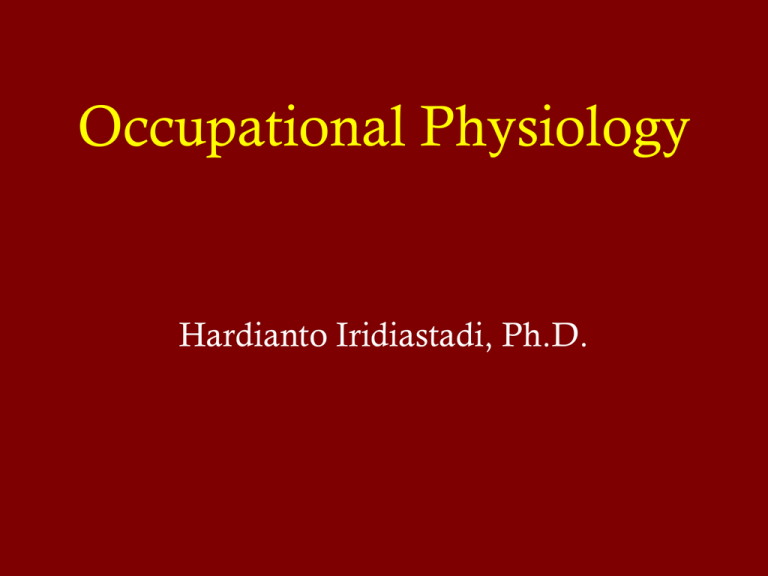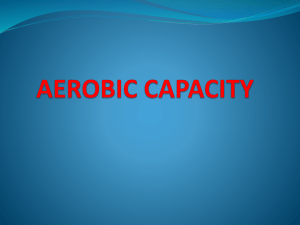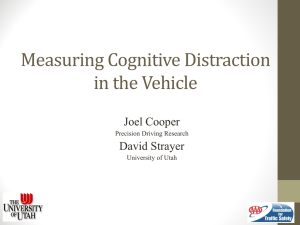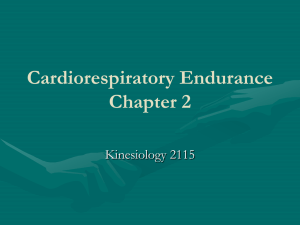Occupational Physiology 2
advertisement

Occupational Physiology Hardianto Iridiastadi, Ph.D. Aerobic Capacity • Definition – Highest oxygen uptake an individual can attain (VO2 max) – Also known as maximal aerobic power • Power = energy available / unit of time – Measurement • Douglas bag • 1 liter O2 ~ 4.7 – 5.05 kcal • Metabolic analyzer Aerobic Capacity From National Institute for Occupational Safety and Health. (1981). A Work Practices Guide for Manual Lifting, Technical Report No. 81-122. Cincinnati, OH: U.S. Department of Health and Human Services (NIOSH) Fig 4.1 Aerobic Capacity • NIOSH (1981) – Male: 15 kcal/min (~3 l/min) – Female: 10.5 kcal/min (~2.1 l/min) Aerobic Capacity Peneliti Responden 10 orang mahasiswa pria (usia 17-23 tahun) 10 orang Rakhmaniar mahasiswa wanita (2007) (usia 19-22 tahun) 16 orang pekerja Satriawan industri pria (2008) (usia 20–25 tahun) 15 orang pekerja Soleman industri wanita (2009) (usia 20–25 tahun) Widyasmara (2007) Yadi (2009) 30 orang TNI AU, AD, dan Polisi (usia 19-25 tahun) Nilai Konsumsi Oksigen VO2max = 2,64 liter/menit (SD = 0,51) VO2’ max = 42,42 ml/menit/kg (SD = 7,25) VO2max = 1,89 liter/menit (SD=0,27) VO2’ max = 33,63 ml/menit/kg (SD = 3,30) VO2max = 3,7 liter/menit (SD = 0,55) VO2’max = 65,11 ml/menit/kg (SD = 9,447) VO2max = 2,5 liter/menit (SD = 0,69) VO2’ max = 52,84 ml/menit/kg (SD = 15,58) VO2max = 4,5 liter/menit (SD = 0,67) VO2’ max = 71,4 ml/menit/kg (SD = 10,63) Aerobic Capacity –Maximal Test • Max (direct) method – Begin at low level – Increase workload until VO2max is reached • Increase in workload does not increase VO2 • Occurs at max HR (~220-age) – Extreme dangers inherent to this method (push systems to their limit • Cannot perform on at risk persons Aerobic Capacity – Sub Maximal Test • Indirectly measure the maximum aerobic capacity – less fatiguing and less dangerous, but much less accurate • Method assumes a linear relationship between heart rate and oxygen consumption (dot indicates rates) – If VO2 = f(HR), then HRmax -> VO2 max - > Emax Aerobic Capacity – Sub Maximal Test • Max heart rate (HR) could be predicted by Max HR = 220 – age, or = 206 – (0.62 x age), or = 190 – (0.62 x (age – 25)) Note, Max HR prediction • No strong scientific backgroud • Has errors (up to 10 bpm) • Not suitable for children Measuring Aerobic Capacity • Methods – Treadmill – Cycle ergometer – Step test, nomogram • Need to involve large muscle groups • Treadmill test – Higher (5 – 11%) AC for inclined treadmill – 7% greater than ergocycle Aerobic Capacity vs Demographics • Gender effect – No differences before puberty – Female ~ 65 – 75% of male’s • Age effect – Peak at 18 – 20 years of age – AC at 65 yo ~ 75% at 25 yo • Jobs – Lower AC among white collar employees Aerobic Capacity vs. Performance • High AC not neccessary for high performance, due to other factors: – – – – Training Experience Psychological state Techniques • AC can be increased for another 10 year via training Maximum Heart Rate • Concept: – Indirect measure of energy – Increased heart rate ~ increased energy production (assumed) – Direct measurement – Indirect Measurement • MaxHR = 206 - (0.62 x age) • MaxHR = 220 – age • MaxHR = 190 – 0.62(age – 25) Workload Assessments Should be based on capacity! Workload Assessment • Direct measurement – Calorimetric chamber • Indirect measurement – Rate of oxygen consumption (l/min) (representative of metabolic process) Workload Assessment • Indirect measurement – Heart rate (bpm) (linearly related to oxygen consumption) Note: Use HR/VO2 as indicator for static component of tasks Workload Assessment – Early Study • Recovery Heart Rate – Brouha Method 1. Measure HR 3 min after work 2. Measure HR at 30”, 90”, 150” (x 2) 3. Determine if recovery is sufficient, or if workload is excessive Workload Assessment – Early Study • Recovery Heart Rate – Brouha Method • If HR1 – HR3 ≥ 10, or if HR1, HR2, and HR3 all below 90, recovery is normal • If the average of HR1 over a number of recordings is ≤ 110, and HR1 – HR3 ≥ 10, workload is not excessive • If HR1 – HR3 < 10, and if HR3 > 90, recovery is inadequate Workload Assessment • Energy cost Sleeping 1.3 kcal/min Standing 2.3 Assembly 3.9 Welding 3.4 Stockroom 4.2 Chopping wood 8.0 Athletic 10.0 Workload Assessment • Energy cost (Kamalakannan et al, 2007) E-cost = -1967 + 8.58HR + 25.1HT + 4.5A – 7.47RHR + 67.8G E-cost: Energy cost (Watt) HR: Working heart rate (bpm) HT: Height (inch) A: Age (yrs) RHR: Resting heart rate (bpm) G: Gender (m = 0; f = 1) 1 Watt ~ 0.0143 kcal/min Workload Assessment • Energy cost (Keytel, 2005) E-cost = -55.0959 + (HR x 0.6309) + (W x 0.1988) + (A x 0.2017) E-cost: Energy cost (kJoule/min) HR: Working heart rate (bpm) W: Weight (kg) A: Age (yrs) 1 KJoule/min ~ 0.239 kcal/min Workload Assessments Astuti (1985) Keytel (2005) Rakhmaniar (2007) Kamalakannan et al. (2007) Persamaan Y = 1,8041 – 0,229038 X + 4, 71733 . 10 -4 . X2 Y = energi (kkal/menit) X = denyut jantung (denyut/menit) EE = -20,4022 + (0,4472 HR) – (0,1263 w) + (0,074 A) EE = pengeluaran energi, HR = denyut jantung (denyut/menit) w = berat badan (kg), A = usia (tahun) Y = 0,014 HR+ 0,017 w– 1,706 Y = konsumsi oksigen (liter/menit) HR = denyut jantung (denyut/menit), w = berat badan (kg) MWR = -1967 + 8.58 HR + 25.1 HT + 4.50 A – 7.47 RHR + 67.8 G MWR = metabolic work rate (W) HR = denyut jantung bekerja (denyut/menit) HT = tinggi badan (inchi), A = usia (tahun) RHR = denyut jantung istirahat (denyut/menit) G = 1 untuk wanita, 0 untuk pria Workload Assessment • Energy cost (Indonesian, male) VO2 = -1.169 + 0.02HR – 0.035A + 0.019W (Adj.R2 = 78.1%) – VO2 = oxygen consumption (l/min) – HR = heart rate (bpm) – W = weight (kg) – A = age (20 – 40 yrs) – VO2max = 3.4 ± 0.55 l/min Workload Assessment • Energy cost (Indonesian, female) VO2 = -1.991 + 0.013HR + 0.024W (Adj.R2 = 63.6%) – VO2 = oxygen consumption (l/min) – HR = heart rate (bpm) – W = weight (kg) – A = age (20 – 40 yrs) • VO2max = 2.3 ± 0. 6/min ? Workload Assessment Workload* Heart Rate (bpm) Light - 90 Moderate 90 – 110 Heavy 110 - 130 Very heavy 130 -150 Extremely heavy 150 - 170 *20 – 30 years old %HRReserve (HRR) = 100% x (HRave – HR-rest)/(HRmax – HRrest) Workload Assessments Kategori Pekerjaan Pengeluaran Energi (kkal/menit) Light < 2.5 Moderate 2.5 – 5 Heavy 5 – 7.5 Very heavy 7.5 – 10 Extremely heavy > 10 From: Wickens (2004) Workload Assessments • Physical Activity Ratio (PAR) – Light – Less than 3 x resting energy – Heavy – About 6 to 8 x resting energy – Maximal – More than 9 x resting energy Workload Assessment • Borg’s Ratings of Perceived Exertion (RPE) Ratings 6 7.5 9 11 13 15 17 19 20 Description No exertion at all Extremely light Very light Light Somewhat hard Hard (Heavy) Very hard Extremely hard Maximal exertion Workload Assessments • Borg’s Category Ratio (CR) 10 0 0.5 1 3 5 7 10 - Nothing at all Extremely weak Very weak Moderate Strong Very strong Extremely strong Workload Assessments • Example (1) – – – – – – Female 30 years old 157 cm 55 kg Working HR = 100 bpm Resting HR = 65 bpm Workload Assessments • Example (2) – – – – – – – Male Working for 5 years 58 years old 156 cm 51 kg Working HR = 112 bpm Resting HR = 65 bpm Workload Assessments • Example (3) – – – – – – – Male Working for 15 years 60 years old 158 cm 55 kg Working HR = 103 bpm Resting HR = 62 bpm Fatigue • Concept – Workload > 30 – 40% of work capacity – Likely experienced at end of shift – Associated with • • • • Tiredness, exhaustion, etc. Impaired performance Increased lactic acid; lower blood glucose Lower job satisfaction and increased health risks – Could be due to other factors (motivation, poor health, etc.) – Experienced also due to static work – HR > 110 after 30 – 60 min of rest Fatigue • Short term – VO2 max • Long term – 33% max (8 hours); 25% max (conservative) – 60% max (1 hr/shift) NIOSH 1981: 3.5 kcal/min for 8 hrs acceptable by 99% of M, 50% of F, 75% of total 1991: 3.1kcal/min if lifting from <30"; 2.2 kcal/min if lifting from >30" to ‘protect’ 50% of F and 99% of M Controls for Demanding Work • Engineering – – – – – – – Decrease load weights Elevate low-lying loads Reduce walk/carry distances Control heat Decrease frequencies Seated work Lifting aids, ... Controls for Demanding Work • Administrative – Work-rest schedules • • • • productivity acceptability feasibility length of rest breaks (many small better than few long breaks) – Team work – Fatigue Monitoring • productivity, discomfort surveys, HR monitoring – Worker Selection • compare capacity with job energy demands Controls for Demanding Work • Rest period R = (Ework – Erec)/(Ework – Erest) E ~ Oxygen consumption R: % of work time Controls for Demanding Work • Rest period = (PWC - Ejob) / (Erest – Ejob) Example PWC = 5 kcal/min Ejob = 6.5 kcal/min Erest = 1.5 kcal/min Rest = 30% of work duration Controls for Demanding Work • Adequate supply of water and sugar • Training (strength vs. endurance) – Max improvement 10 – 20% • Changes to training and work pace often not possible; rest is more feasible







